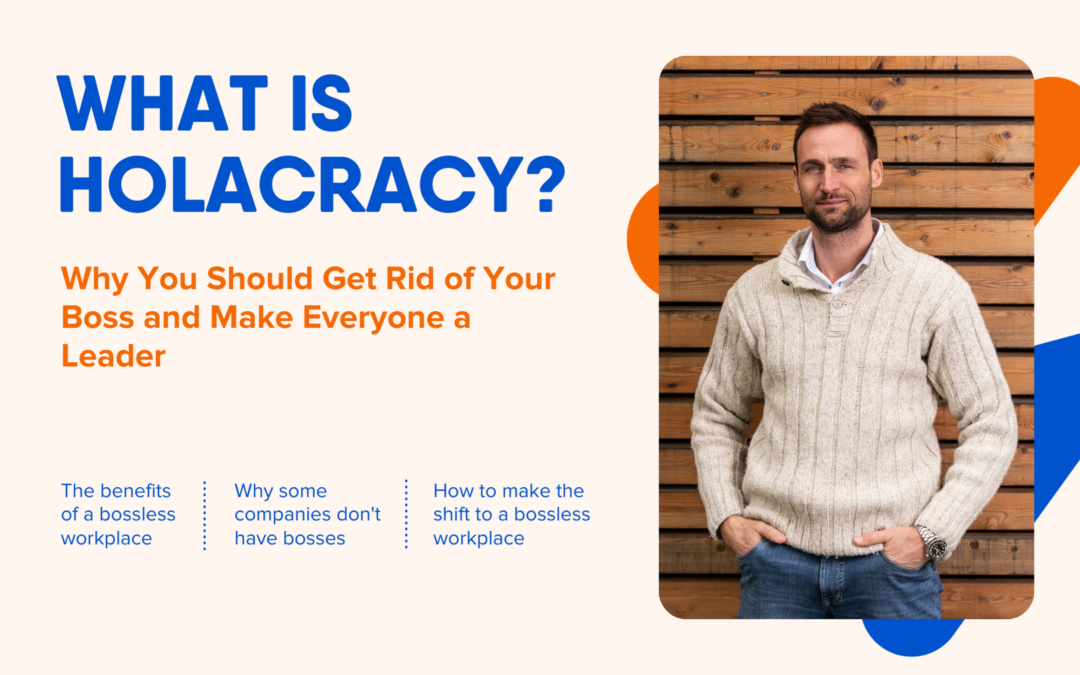What if your boss could be any of your colleagues? Would working get easier, more productive, and enjoyable that way?
What if you didn’t have a boss but rather peers who are all leaders and whom you can trust to help you succeed in your work?
What sounds like a perfect work utopia is in fact an emerging trend. In recent years, we’ve seen an increase in the number of companies that implement holacracy (an organization with no managers where everyone is a leader).
These practices empower employees by eliminating traditional management roles and giving everyone decision-making ability. In this article we explain what a bossless workplace is and why it works. We also discuss common challenges to adopting these principles at work and how you can start making these changes at your company.
What is holacracy?
Holacracy is a way of organizing a company. It’s a system that is different from the traditional hierarchical structures that most companies use. The concept behind holacracy is that a company is a complex system.
No one person can understand and control the entire system. You need people who are experts in certain processes and who can make decisions about their part of the organization. These people have the authority to make decisions in their own area of the company, but they don’t have the power to make decisions for other parts of the organization. There are no boss-employee relationships in holacracy.
Instead, people are grouped into different circles. Everyone is part of several circles. Circles contain people who do similar work, such as marketing or design.
Why you should get rid of your boss
This might sound like a utopia, but in fact, there are good reasons to get rid of your boss. The main reason is that this allows you to do your job more effectively.
When you have a manager who has more power than you, you have to spend time doing things that are not related to your actual job. You have to spend time pleasing your manager, and you have to wait to get permission to do things that you should be able to do on your own.
All of this means that you spend less time actually doing your job—you spend less time doing your job.
Why should you have to spend time pleasing your manager? After all, you are both doing your jobs: you are the one who is actually producing the results, and your manager is the one who is managing you. You should be able to do your job effectively and efficiently, and you should be able to do it without having to take into account your manager’s desires.
The benefits of a bossless workplace
There are various benefits to implementing a bossless workplace. We’ve listed a few below.
– No one gets a promotion – Aside from offering more opportunities for professional growth and fostering a culture of continuous learning, a bossless workplace creates opportunities for employees in all stages of their careers.
– More authentic relationships – Bosses often have favorites. This creates the potential for resentment among other employees. Without a boss, the relationships among colleagues are more authentic and equitable.
– Better collaboration – With no one person to whom others are expected to defer, there’s more opportunity for collaboration between colleagues.
– Better company culture – No one has to follow a boss’s orders just to keep their job. This makes it easier to build an inclusive and supportive work environment.
– Better decision-making – Management-by-committee often causes people to get stuck in decision-making limbo. With no manager, employees have the authority to make decisions when it’s necessary.
3 reasons why most companies don’t have bosses right now
There are a couple of reasons why most companies don’t have bosses. These aren’t just talking points—they’re backed up by studies and real-world examples.
1 – Management doesn’t really work – A lot of companies have tried the traditional hierarchical management structure, but it doesn’t really work. It’s inefficient, it causes problems with company culture, and it doesn’t get the best results.
2 – The rise of the digital nomad – As more people work remotely, companies realize that they don’t need traditional management structures because they don’t have offices.
3 – Technology makes it easier to manage people – The information technology that people use to communicate and collaborate also makes it easier to manage people.
And what if robots will replace people? – OK, maybe this one won’t happen any time soon, but in the distant future, artificial intelligence might make it even easier to manage people.
How to make the shift to a bossless workplace
We’ve discussed the benefits of a bossless workplace, but how can you actually make the shift from having a traditional managerial structure to having a bossless workplace?
First of all, you should be aware that it’s not as sudden of a change as it might seem. If you’re making changes that move your company toward a bossless workplace, you may not even realize it. You might implement practices that move you in the direction of a bossless workplace but that have been traditionally used in managerial organizations.
Conclusion
In this article, we’ve explored what a bossless workplace is and why it works. We also discussed common challenges to adopting these principles at work and how you can start making these changes at your company.
Finally, we end with a reminder that nothing is set in stone. The organizational structure that works best for you may change over time. This flexibility will help you adapt to your ever-changing environment and thrive.
If you need a sounding board for this topic, get in touch.
Our social media is where we regularly share tips and content for balancing life and business and enjoying both.
